|
Related FAQs: Butterflyfishes in General, Butterflyfish
Foods/Feeding/Nutrition, Butterflyfish Selection, Butterflyfish Disease, Butterflyfish Disease 2, Angels and Butterflyfishes & Crypt,
Hawaiian
Butterflyfishes, Butterflyfish
Reproduction,
Related Articles: Amphichaetodon; Chaetodon ( Auriga/Threadfin, Raccoon/Lunula, Double
Saddle-Back), Chelmon, Chelmonops, Coradion, Forcipiger, Hemitaurichthys, Heniochus, Johnrandallia, Parachaetodon, Prognathodes
Regional Accounts of
Butterflyfishes: Hawai'i, Cook Islands, Fiji, Red
Sea, Maldives
Corallivorous Butterflyfishes… For Aquariums?
|
|
|
Bob Fenner
|
|
 |
Butterflyfishes for Marine Aquariums
Diversity, Selection & Care
New eBooks on Amazon: Available
here
New Print Book on Create Space: Available
here
by Robert (Bob) Fenner |

Amongst the member species of the family of marine
Butterflyfishes, Chaetodontidae, there are stalwart examples of almost
the entire range of food-gathering types… Sans filter-feeders, and top
piscivore predators, they span the gamut of generalized planktivores,
various favored invertebrate fauna and algal/aufwuchs pickers, to those
who are mostly to entirely obligate consumers of live coral polyps.
Don’t mistake me here; I am a giant fan of the aforementioned more
generalized feeders… Aurigas, the Threadfin, the Raccoons, Forcipigers,
or the FAB, though expensive members of the sub-genus Roa that are the
better choices for aquarium use; but… the amongst the Chaetodontids that
exclusively eat corals are some real beauties… And… yes; they ARE found
on reefs (all Butterflies are at least reef-associated).
Here are the details concerning which species, often sold as
“miscellaneous Butterflies” (omitting ones that don’t show up in the
trade) are obligates (or near to it); and some hopefully pertinent notes
re how you might go about meeting the challenge of their captive care
longer term.
Complete & Near Obligate Corallivorous Butterflyfish Species:
|
Chaetodon aureofasciatus
Macleav 1878, the Golden-Striped
Butterflyfish. From all along
Australia's northern coast over to New
Guinea. A coral polyp feeder. Image from
off of Queensland in Australia.
|

|
|
Chaetodon austriacus,
Ruppell 1835, the Red Sea Melon or
Exquisite Butterflyfish. A Red Sea and
Gulf of Aden endemic. Never lives in
captivity, unlike so many of the other
fishes hailing from this area. A feeder
on live corals, anemones and snail eggs.
Pic from the Red Sea.
|

|
|
Chaetodon baronessa
Cuvier 1831, the Eastern Triangular or
Baroness Butterflyfish. Like the similar
Indian Ocean congener, Chaetodon
triangulum, this fish is a strict
feeder on coral polyps. Too often
shipped out of Fiji (here at a
collector’s), the Philippines and
Indonesia. To six inches in the wild.
|
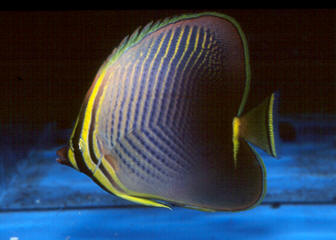
|
|
Chaetodon bennetti Cuvier
1831, Bennett's Butterflyfish. Central
Pacific to Africa's east coast. To about
six inches total length. Most all food
consists of coral polyps. A nice adult
down in Wakatobi, S. Sulawesi, Indonesia
shown.
|
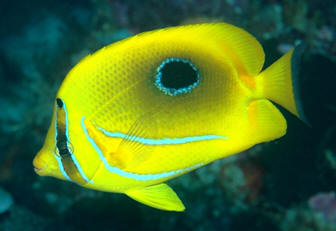
|
|
Chaetodon larvatus
Cuvier 1831, the Masked or Orange-Face
Butterflyfish. Restricted in range, Red
Sea to lower Gulf of Aden. Only eats
Acroporid coral polyps... Closely
related to C. baronessa, C.
triangulum. To five inches long.
Aquarium photograph.
|

|
|
Chaetodon lunulatus
Quoy & Gaimard 1824, the Redfin
Butterflyfish. Easily confused with the
Indian Ocean Redfin Butterflyfish,
Chaetodon trifasciatus, this western
Pacific to Hawaii congener fares no
better in captivity. To about six inches
long in the wild... leave it there.
Here's a specimen in Hawaii.
|
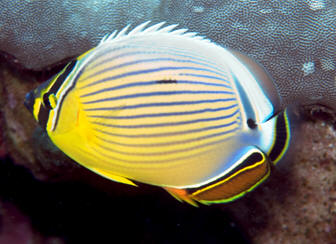
|
|
Chaetodon melapterus
Guichenot 1862. Arabian or Black-Finned Melon Butterflyfish.
Coming from the middle of the Red Sea down and around Yemen, Oman
into the Persian Gulf, this is another "principally coral
polyp feeder". To about five inches in length. Aquarium
image. Thanks to Matt Petersen for reminding me of this BF absence as a
corallivore.
|

|
|
Chaetodon meyeri
Bloch & Schneider 1801, Meyer's
Butterflyfish. Widespread in the Indian
Ocean to western Pacific Oceans, this
species is another loser that is
too-frequently sold as a "miscellaneous"
butterfly. Only eats coral polyps... In
Wakatobi, S. Sulawesi.
|
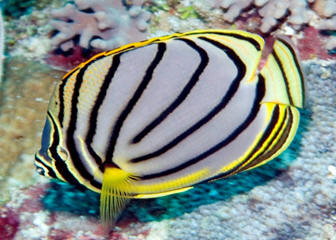
|
|
Chaetodon octofasciatus
Bloch 1787, the Eight-banded
Butterflyfish. Often sold as a "misc."
butterfly, this is a strict feeder on
coral polyps... rarely lives more than a
few days. A less yellow than usual one
in the Gilis, N. Lombok, Indo.
|

|
|
Chaetodon
ornatissimus
Cuvier 1831, the Ornate Butterflyfish.
Yet another obligate corallivore. Yes, a
beauty, but does not live in home fish
tanks. Indo-west Pacific, Including
Hawaiian Islands. To about seven inches
in length. Commonly offered, doesn't
live. Adults in Hawai'i and captivity by
RMF.
|

|
|
Chaetodon plebeius
Cuvier 1831, the Blue-Spot
Butterflyfish. Maldives eastward to the
South Pacific (Fiji). A beauty that is
often sold in the trade and rarely lives
for any period of time to speak of. This
image from Queensland, Australia. Mainly
eats Pocillopora
damicornis. A cleaner
of other fish’s parasites as juveniles.
|

|
|
Chaetodon quadrimaculatus
Gray 1831, the Four-Spot Butterflyfish.
Found in the central to western Pacific,
including Hawai'i. To six inches long. A
few specimens live and live, most die
"mysteriously" in aquarium conditions.
In the wild, this species feeds
principally on Pocillopora coral
polyps. Shown, an adult in Roratonga,
Cook Islands. Strangely, one of the
forty allowed “clean list” species of
fishes legal out of Hawaii.
|

|
|
Chaetodon rainfordi
McCulloch 1923, Rainford's
Butterflyfish. Only from Australia's
Queensland coast up to New Guinea. A
delicate beauty that is far too often
offered in the industry. To six inches
overall in length. Australian
(Queensland) Images of a four inch
specimen off Heron Island.
|

|
|
Chaetodon reticulatus
Cuvier 1831, the Reticulated
Butterflyfish. Nice looking, and
"friendly" underwater toward divers, but
dismal survival records in captivity for
this coral polyp eater. Found commonly
in central and western Pacific. To six
inches total length. One in N. Sulawesi.
|

|
|
Chaetodon trifascialis
Quoy & Gaimard 1824, Chevron
Butterflyfish. This fish is way too
often offered in the trade, belying it's
wide distribution, mid-Pacific to the
east coast of Africa and the Red Sea.
Almost exclusively lives on eating
Acropora hyachinthus polyps. To
seven inches in length. One in Fiji.
|

|
|
Chaetodon trifasciatus Park
1797, the Melon or Indian Ocean Redfin
Butterflyfish. Like the same named
Redfin Butterflyfish from the Pacific
this is primarily a coral polyp feeder.
Note the I.O. species much bluer dorsal
coloration To about six inches long in
the wild. One in the Maldives
|

|
Oh, and Coral Plus Eaters!
Yes; there are quite a few other Butterflyfish species that consume a
modicum of live corals and other stinging-celled life in the wild. In
fact; all Chaetodontids will “cross the line” given hunger and some just
opportunity. For brevity’s sake I’ll just list a few of these offendis
that make it into the trade occasionally.
|
Chaetodon adiergastos
Seale 1910, the Panda Butterflyfish. Far
west tropical Pacific in distribution. A
coral polyp plus other invertebrate
feeder. To six inches total length. This
one in Raja Ampat, Indonesia.
|

|
|
Chaetodon
citrinellus
Cuvier 1831, the Speckled Butterflyfish.
Aggressive in the wild, this is another
broad feeder of invertebrates, including
corals. Widely distributed and common,
though never plentiful in the
mid-Pacific all the way over to Africa.
To five inches overall. An adult one in
Fiji.
|

|
|
Chaetodon
ephippium
Cuvier 1831, the Saddleback
Butterflyfish. To a large size (9") and
too often collected too large for
aquarium use (get one 3-4" best).
Central and western Pacific. Very nice
out of Hawai'i for use in the U.S. Broad
feeder on benthic invertebrates
including coral polyps. S. Sulawesi
image.
|
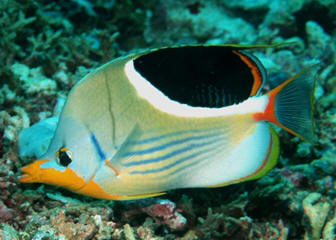
|
|
Chaetodon
flavirostris
Gunther 1873, the
Black or Yellow-Faced Butterflyfish.
Usually shy and non-feeding. Eats coral
polyps, other bottom-dwelling
invertebrates and algae in the wild. To
some eight inches long. Way too often
sold to the hobby as juveniles... they
don't live. One in the Cook Islands.
|
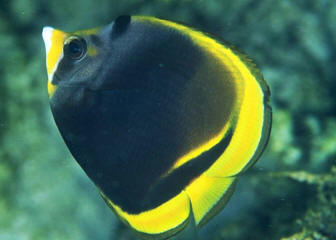
|
|
Chaetodon fremblii
Bennett 1828, the Blue-Striped
Butterflyfish. A relic species confined
in range to the Hawaiian Islands.
Opportunistic feeder on benthic
invertebrates including corals. To five
inches total length. Pictured here in
captivity Hawaii.
|

|
|
Chaetodon guttatissimus
Bennett 1832, the Spotted Butterflyfish.
Some folks rate this species higher for
aquarium use, but it takes a beating
often in transit, especially its small
mouth. Tropical Indian Ocean. To five
inches long. Generalized feeder on
invertebrates (including coral polyps),
and algae. An adult in the Maldives.
|
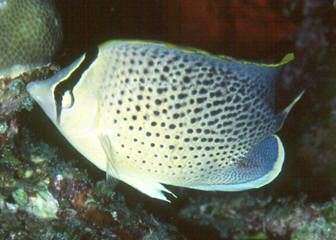
|
|
Chaetodon lineolatus
Cuvier 1831, the Lined Butterflyfish. At
a foot long, vying for largest
Butterflyfish of the family. Widespread
from Hawai'i over to the east coast of
Africa, into the Red Sea. A beauty that
eats corals, anemones, much of all else,
but doesn't live. Below: One in Hawai'i.
|

|
|
Chaetodon pelewensis
Kner 1868, the Sunset or Dot-Dash
Butterflyfish. Very similar to the hardy
Spot-Banded Butterflyfish, Chaetodon
punctatofasciatus (see in "Good"
Chaetodon section) but with oblique body
barring versus vertical. Southern
Pacific Ocean area. To five inches
length overall. This one in the Cook
Islands.
|
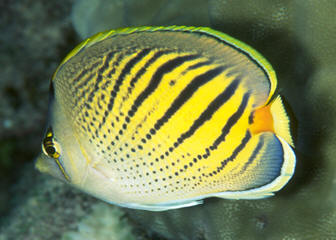
|
|
Chaetodon speculum
Cuvier 1831, the Mirror or Oval-Spot
Butterflyfish. A shy species that lives
in coral rich areas where it feeds on
same and other benthic invertebrates. To
some seven inches in length. Eastern
Indian Ocean to western Pacific. Ones
off of Bunaken, Sulawesi, Indonesia.
|

|
|
Chaetodon vagabundus
Linnaeus 1758, the Vagabond, Crisscross
Butterflyfish. In the wild feeds on
anemones, coral polyps, worms and algae.
Compared with the similar Indian (Ocean)
B/F (see above), Chaetodon decussatus,
this species does poorly in captivity.
One in Fiji.
|

|
Hardiness of Butterflyfishes Period? Meh!
Truth be told, or written in this case, Chaetodontids aren’t really very
aquarium-tough animals en toto. Most species, specimens take a real
beating in the course of collection in the wild (none are commercially
captive-produced); holding and shipping. They REALLY don’t like small
spaces, get easily ammonia burned… So… I would like to impress on you
some key criteria in going about picking up better individuals if you’re
stocking them:
1)
KNOW what you’re getting into, the challenges involved in keeping
the species you have in mind!
2)
Don’t buy just-arrived specimens!
3)
Beware of too small AND too large individuals. Little ones can’t
take the rigors of being caught, bagged, starved… Big ones are often too
set in their wild-ways, easily damaged from being moved in too-little
water, bag
4)
Be prepared to expedite these fishes; likely skipping quarantine
in favor of a 30-60 second dip/bath. The trade off in risk of pathogenic
disease introduction for reduced stress is a good gamble IF you’ve done
your job in securing initially healthy specimens.
Provide at least a hundred gallon system that is well-established;
with reef-quality conditions of optimized, stable water quality.
5)
Be careful regarding foods and feeding of all specimens. During
daylight hours these fishes should be out and about foraging…
continuously.
6)
STAY observant. IF your Butterfly is picking on one colony too
much, either move it to separate quarters or cover it with a plastic
colander, inverted berry basket or such to allow it time to recover.
Cloze:
Being too
specialized carries risk of trouble should there be resource depletion (Beruman
et al. 2008); but think about what sorts of foods you might “choose” if
you lived on the world’s tropical reefs. Obviously there are many coral
polyps; and though they’re principally water, and can pack some nasty
sticky, stinging distasteful chemicals; many beautiful Butterflyfishes
have targeted them through space and time as their principal source of
nutrition.
How might you go about keeping these fishes? Do you have the space, mix
of Cnidarians, capacity for salvaging possibly over-sampled colonies?
What might you do to entice you obligate corallivores onto other food
items?
The “standard” Butterflyfishes of the trade are historically much more
hardy (orders of magnitude better mid-term survivability) than those
that have to eat live polyps… but there were times that folks couldn’t
get the Cichlids called Discus (Symphysodon) to eat prepared foods as
well.
Even the most stellar species, specimens of this family live for
much time in captivity; likely less than one percent surviving a year
from extraction from the wild. Are these good odds, fair enough for you
to give them a try?
Bibliography/Further Reading:
Food Selection in Two Corallivorous
Butterflyfishes, Chaetodon austriacus and C. trifascialis, in the Northern Red
Sea. Magdy Alwany, Ellen Thaler, Michael Stachowitsch, Marine Ecology Volume
24, Issue 3, pages 165–177, September
2003
Trade-offs associated with dietary specialization in corallivorous
butterflyfishes (Chaetodontidae: Chaetodon) Berumen, Michael L, and
Pratchett, Morgan S (2008) Trade-offs associated with dietary
specialization in corallivorous butterflyfishes (Chaetodontidae:
Chaetodon). Behavioral Ecology and Sociobiology, 62 (6). pp.
989-994.
Resource use by Corallivorous Butterflyfishes (Family Chaetodontidae) in
Hawaii, Cox, Evelyn F.
Bulletin of Marine Science,
Volume 54, Number 2, March 1994 , pp. 535-545(11)
 |
Butterflyfishes for Marine Aquariums
Diversity, Selection & Care
New eBooks on Amazon: Available
here
New Print Book on Create Space: Available
here
by Robert (Bob) Fenner |
|
|


